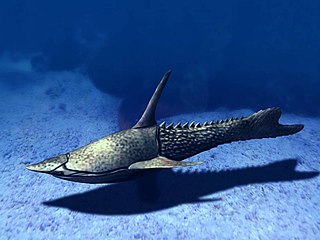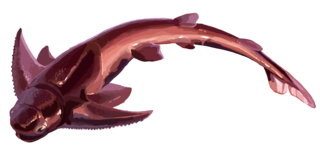
Placoderms are members of the class Placodermi, a group of prehistoric fish known from Paleozoic fossils which lived from the Silurian to the end of the Devonian period. While their endoskeletons are mainly cartilaginous, their head and thorax were covered by articulated armoured plates, and the rest of the body was scaled or naked depending on the species. Placoderms were among the first jawed fish; their jaws likely evolved from the first pair of gill arches.

Protaspididae is an extinct family of pteraspidid heterostracan agnathans. Fossils of the various genera are found in early Devonian-aged marine strata. Protaspidids were once thought to represent a transitional form between the Pteraspididae and the Psammosteida, bearing the broad head shield shape of the latter, due to a more benthic (bottom-dwelling) existence, but recent phylogenical comparisons demonstrate that the protaspidids are actually highly derived pteraspidids, and that the anchipteraspidids, the most primitive of pteraspidids, are the sister-group of the Psammosteids.

The class Osteostraci is an extinct taxon of bony-armored jawless fish, termed "ostracoderms", that lived in what is now North America, Europe and Russia from the Middle Silurian to Late Devonian.

Macrodontophion is the name given to a dubious genus of lophotrochozoan from the Early Devonian Dniester Series of Podolia, Ukraine. It was described by Adalbert Zborzewsky in 1834, but was never given a species epithet, and is considered a nomen dubium, because it is based only on fragments, such as the holotype, a shell of 25 millimetres (0.98 in).

Drepanaspis is an extinct genus of primitive jawless Ostracoderms from the Early Devonian that belonged to the phylum Chordata, infraphylum Agnatha, class Pteraspidomorphi, and the subclass Heterostraci. Drepanaspis are assumed to have lived primarily in marine environments and is most commonly characterized by their ray-like, heavily armored bodies, along with their lack of paired fins and jaws.

Pituriaspis doylei is one of two known species of jawless fish belonging to the Class Pituriaspida, and is the better known of the two. The species lived in estuaries during the Givetian epoch of the Middle Devonian, 390 million years ago in what is now the Georgina Basin of Western Queensland, Australia.

Lunaspis is an extinct genus of armor-plated petalichthyid placoderm fish that lived in shallow marine environments of the Early Devonian period, from approximately 409.1 to 402.5 million year ago. Fossils have been found in Germany, China and Australia. There are three different identified species of within the genus Lunaspis: L. broilii, L. heroldi, and L. prumiensis.

Holonema is an extinct genus of relatively large, barrel-shaped arthrodire placoderms that were found in oceans throughout the world from the Mid to Late Devonian, when the last species perished in the Frasnian-Fammian extinction event. Most species of the genus are known from fragments of their armor, but the Gogo Reef species, H. westolli, is known from whole, articulated specimens.
Semipodolaspis is an extinct genus of jawless fish.
Palanasaspis chekhivensis is an extinct species of pteraspidid heterostracan agnathan which existed during the Pragian epoch of the early Devonian period in what is now Podolia, Ukraine. It is known primarily from a wide rostral plate, which is referenced in the generic name, a compound word combining the Latin words pala, "shovel," and nasus, "nose," with the Greek suffix aspis, "a small shield." Although the rostral plate clearly marks the creature as a pteraspidoid heterostracan, that literally nothing else of its anatomy is known forces researchers to leave it as incertae sedis.
Djurinaspis is an extinct genus of jawless fish which existed during the early Devonian period. It was originally described by Novitskaya in 1983. A new species, D. secunda, from Ukraine was described by Victor Voichyshyn in 2011.

Podolaspis is an extinct genus of pteraspidid heterostracan agnathan which existed during the early Devonian period. It was originally described by Zych in 1931, and contains the species P. lerichei, and P. danieli.
Podoliacanthus is an extinct genus of Acanthodii which existed in what is now Greenland and Ukraine during the early Devonian period. It was described by Victor Voichyshyn and Hubert Szaniawski in 2012, and the type species is Podoliacanthus zychi. It also contains three presently undescribed species.

Brachydeirus is a genus of small to moderately large-sized arthrodire placoderms from the Late Devonian of Europe, restricted to the Kellwasserkalk Fauna of Bad Wildungen and Adorf.

Oxyosteus is a genus of trout-sized, highly compressed arthrodire placoderms from the Late Devonian of Europe: The two described species are restricted to the Late Frasnian-aged Kellwasserkalk Fauna of Bad Wildungen, while a median dorsal plate of an unnamed species is known from the Middle Frasnian Holy Cross Mountains of Poland.
Microbrachius is an extinct genus of tiny, advanced antiarch placoderms closely related to the bothriolepids. Specimens range in age from the Lower Devonian Late Emsian Stage to the Middle Devonian Upper Givetian Stage. They are characterized by having large heads with short thoracic armor of an average length of 2–4 cm. There are patterns of small, but noticeable tubercles on the armor, with the arrangement varying from species to species. Specimens of Microbrachius have been found in Scotland, Belarus, Estonia, and China.

Furcacaudidae, the "'fork-tailed' agnathans," is an extinct family of thelodontid agnathans from the Lochkovian stage of the Early Devonian epoch and Wenlockian epoch of the Silurian, known from fossils found in Northern Canada. It is the type family of the order Furcacaudiformes, and itself currently includes 6 known species. It was officially described in 1998 by Mark V. H. Wilson and Michael W. Caldwell.

Zenaspididae is an extinct family of jawless fish in the order Zenaspida.

Kujdanowiaspis is an extinct genus of arthrodire placoderm fish from the Early Devonian of Podolia (Ukraine), Poland and Spain. Kujdanowiaspis is known from many fragmentary head shields and body armours.

Wladysagitta is an extinct genus of osteostracan jawless fish that existed during the lower Devonian period of what is now Podolia, Ukraine. This taxon was named in honor of Polish paleontologist Dr. Władysław Zych (1899–1981), and from the Latin sagitta, meaning arrow, which is in reference to the arrow-like shape of its skull.

















